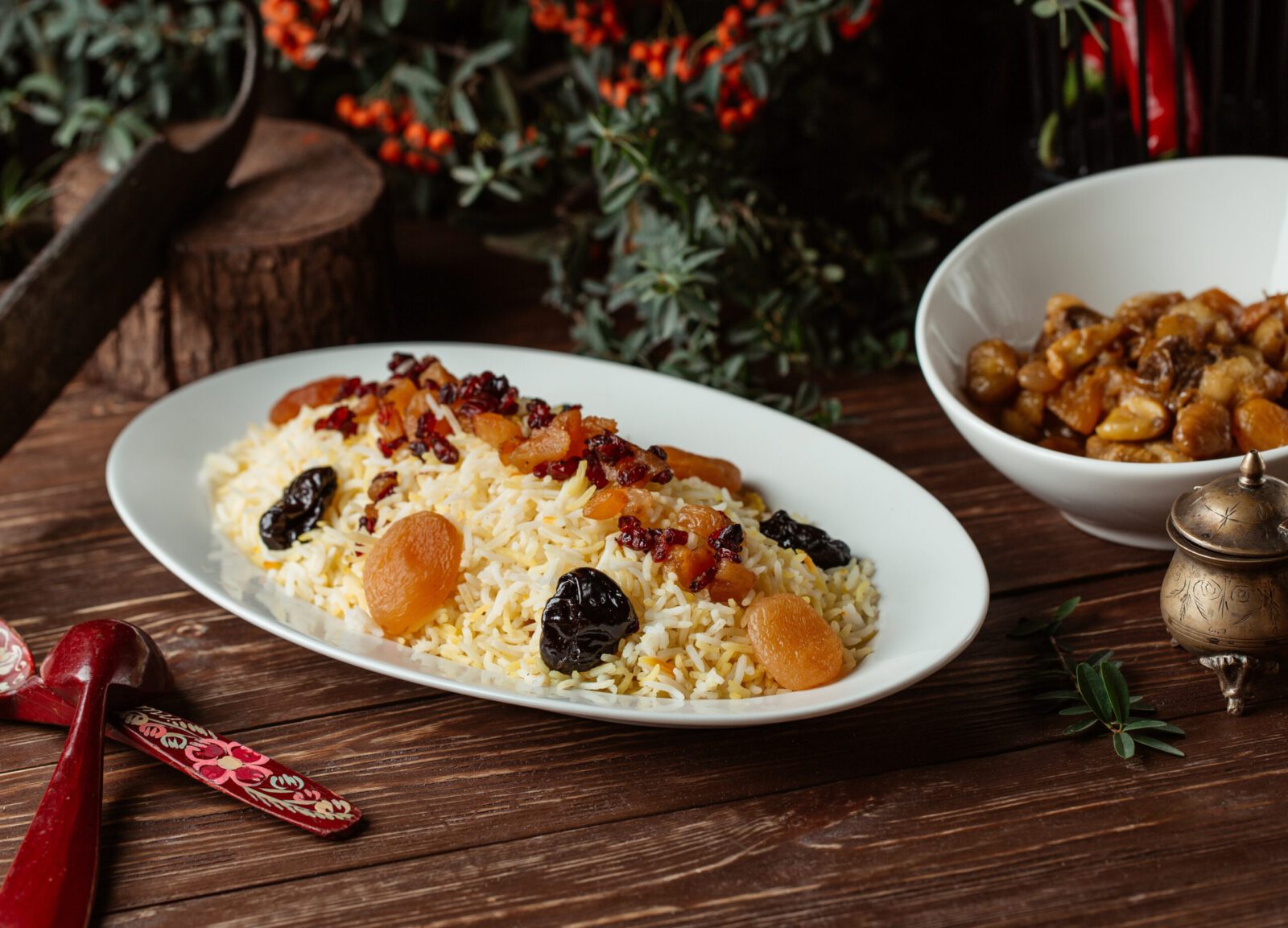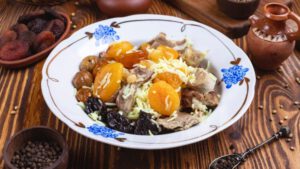Prepare a 3-course Azerbaijani feast with Jamila Qadir’s recipes for plov, kofta and ajabsandal.
If kebab or shishlik is the king, then ash or plov is the queen.
That’s how Jamila Qadir, a Dubai-based journalist describes the cuisine of her homeland, Azerbaijan. While there are fewer Azerbaijani restaurants in Dubai than the fingers you can count on one hand (Jag restaurant is one of them), Jamila believes that the best place to taste Azerbaijani food is in an actual home.

Tune in to our podcast (or read the transcript) to learn about plov and other Azerbaijani foods as well as the history behind them with Jamila. And read on to get Jamila’s recipes for a 3-course Azerbaijani meal featuring plov, kufte and ajabsandal.
Want more of our scrumptious podcast episodes? Feast on our main podcast page here!
Subscribe on: Apple Podcast App | Spotify (available on AppStore and Google Play) | Google Play Music(currently supported only for listeners in US/Canada) | Anghami
ASH OR PLOV
Ash, or plov, is a festive dish in our culture. It is rice with chicken and dried fruits. It is not eaten everyday, rather usually on special occasions. There are multiple varieties of this gorgeous dish, so this is the classic recipe. Ash is considered the ‘queen of all the dishes’ due to its rich and tasty nature.
Serves: 4
Ingredients:
- 5 cups of basmati rice
- 1 whole chicken (1 to 1.2kg)
- 5 medium sized onions
- 200g butter or 1 cup of oil
- 20 chestnuts
- Cup of raisins
- Handful of other dried fruits
- A few threads of saffron
Method:
Chicken, raisins, chestnuts and dried fruits:
Cut chicken into pieces and cook it without oil or water in a pot. Let it cook in its own juices and fats.
In the meantime dice onions thinly and fry until golden brown.
Wash raisins and other dried fruits and keep them ready in a bowl.
Make small incisions with a knife on chestnuts.
Put a pot of water to boil and put salt in it. Put the chestnuts in and once they’re half-cooked (cooked but not very soft) shell them and keep them aside.
Put chicken on top of onions then add raisins, chestnuts, and other dried fruits and let the mixture cook at very slow fire.
Rice:
Put a pot of water to boil and add some salt. Once the water is boiling put rice and boil it. Stir from time to time and taste to check whether the rice is still hard or soft. Don’t make it very soft, it should be al dente (each rice grain separates from the other). While rice is boiling you can start to prepare the saffron solution, which will give ash its distinct flavor.
Saffron solution:
Put saffron in a small pot with handle, add boiled water and bring it to boil and immediately remove from fire. Keep it aside.
When rice is ready, drain it and put saffron solution on the rice. Set aside. In the meantime melt some butter in the now empty pot of rice. Once the butter is melted and is almost boiling, put the rice back in the pot and put the lid on. Let it cook on a very slow fire.
Let it steam for some time on a low heat and from time to time remove the lid of the pot and drain excess moisture and put the lid back.
Try the rice and when you feel it’s cooked and not hard anymore, then the rice is ready.
Serving:
Put the rice on a big plate. Put it in the middle of the table and on another big plate put the chicken and fruits and let everyone serve themselves from both plates.
Don’t serve it with fizzy drinks, you can serve sherbet – it’s made of sweetened boiled water with threads of saffron and lemon juice.
The amount of sugar and lemon depend according to how sweet or sour you like it. Around 1 to 2 tbsp of lemon juice is enough. Serve it chilled with a slice of lemon inside.
KUFTE BOZBASH
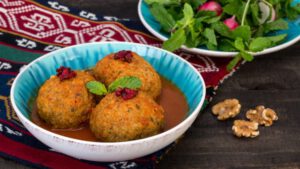
Source: Shutterstock
Kufte is a very interesting dish that can serve both as soup and main course. It is a two-in-one. The meat used in kufte should be only lamb/mutton. It’s a soup with big meatballs, potatoes, and chickpeas.
Serves: 4
Ingredients:
- 800g minced lamb or mutton
- 4 big potatoes, halved
- 100g chickpeas
- Herbs to garnish (mint or coriander)
- 4 medium onions
- Cup of rice
- 1 teaspoon turmeric
- Salt and pepper according to taste
- Prunes, 1 for each meatball
Method:
Soak the chickpeas overnight or for at least 3 hours.
Mince the meat (unless already minced).
Grate onions. Mix the onions with mince and put salt as to your preference.
Divide the meat into equal portions depending on what size you want the meatballs. A good reference is to cup your hands together and make a ball shape. You want the meatballs to be approximately that size.
Form the meatballs from the portions and squeeze the prunes into the center of each meatball.
Boil 1.5ltr of water in a pot. Put in the meatballs and add salt. Let it cook.
Bring it to boil then put in chickpeas. When the meatballs are half-cooked, add potatoes and turmeric, mix, and let it cook. Before serving, add thinly cut mint or coriander to garnish.
AJAPSANDAL
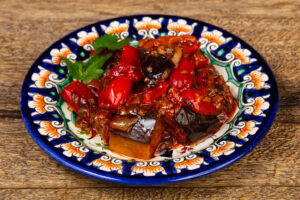
Source: Shutterstock
This dish which remotely reminds of the French ratatouille can be cooked with meat or without as a vegetarian dish.
Serves: 4
Ingredients:
- 0.5kg lamb/mutton/beef, cubed (exclude for vegetarian version)
- 2 medium sized onions
- 1 big eggplant or 2 medium sized eggplants
- 1 bell pepper
- 2 medium sized potatoes
- 3 medium sized tomatoes
- 1 teaspoon turmeric
- Salt, pepper according to taste
- 100g butter or 1 cup of oil
Method:
Put oil in a frying pan and then put in the meat cubes. Cook it at high temperature while constantly stirring so it doesn’t get burnt. Stir for approximately 15 minutes until meat is golden brown, then add chopped onions and stir until onions are golden brown.
Prepping the veggies:
Wash the produce and cut their stems. Cut potatoes and bell peppers into small cubes and slice the tomatoes.
Add eggplants into the frying pan and mix.
Add bell peppers and mix.
Add potatoes and turmeric and mix.
Add tomatoes.
Let it cook on a small fire, stirring from time to time and tasting to check for salt and pepper.
The dish is ready when the meat is tender and the oil is separated from the juices of the food.
Not a fan of audio? Here’s the show transcript for you to read!
- Jamila’s passion for Azerbaijani cooking
- Historical tidbits on Azerbaijani food
- A description of Azerbaijani food for someone who’s never tried it before
- 3-course Azberbaijani meal
Arva: This show is brought to you by Dubai’s most gluttonous food tour company, Frying Pan Adventures. And you’re listening to Deep Fried.
Hey there, I’m your host Arva Ahmed and thanks for joining me on the show That’s inspired by flavors of the East. This podcast celebrates the flavors that we as storytellers, content creators and food tour guides with Frying Pan Adventures have discovered in Dubai.
And one of those flavors is the flavor of Azerbaijan. Now Dubai has a grand total of maybe two Azerbaijani restaurants when I last checked and they’ve come up in the last, maybe three to five years after the trio of Georgia, Armenia and Azerbaijan started marketing themselves heavily as travel destinations to us folks here in Dubai.
And that increased travel naturally sparked an interest in the food. But Azerbaijani home cooks will tell you that restaurant cooking will not capture, it just won’t convey the full story of the cuisine. Cause for that, you need to step into the homes. You’ve got to meet the mothers and grandmothers, who’ve nurtured this cuisine through the generations.
And that’s why we’ve called on Jamila Qadir, an Azerbaijani journalist based in Dubai for the last 20 years. She’s also a mom of an 18 year old daughter and a little cat called Tiska, and she continues to bring alive the flavors of her native cuisine at home. We’ve called on Jamila to help us get a little virtual taste of what Azerbaijani food is all about.
Hi, Jamila. Welcome to the show.
Jamila: Hi, how are you?
Jamila’s passion for Azerbaijani cooking
Arva: Great. Thank you. I’m really excited to chat Azerbaijani food. So when we spoke before the podcast, it was pretty clear that you feel really strongly about traditional Azerbaijani recipes. So where did that passion come from?
Jamila: Well, I think everyone is passionate about food, and especially our cuisine is very rich, it full of flavors. So you can’t, you can’t just stop loving it. You won’t be able, once you try it, you will want to go back and try more and more. As far as the cooking, you know, my mom was a great cook and she used to tell me no, whatever I’m cooking, it will never match whatever my mom cooked. And now I’m telling my daughter that, you know, my mom cooked better. I knew how my mom was cooking. I watched my mom cooking. But obviously if there is a great cook at home, so you won’t be cooking. So, and once I lost my mother, I started cooking. Obviously it was, it was a necessity and whatever I saw, whatever she was doing, so I just did the same way. I incorporated some more stuff in it.
I like cooking our food. I mean, sometimes I do cook dishes from some other cuisines, like you know, like pasta pizza. And I will tell you about the history of our cooking. Actually you know pasta and pizza, it all came from, I won’t say Azerbaijan but from the Turkic people.
Arva: Controversial statements here. I can’t wait to hear about this.
Historical Tidbits on Azerbaijani food
Jamila: Yeah. Might be. So let me put it this way. A little bit of background into the history of Azerbaijan. So Azerbaijan is one of the Transcaucasian Republics. Caucasus, in Caucasus we call it Transcaucasia. It is in between, it’s Eurasia actually, part of Eurasia also. So we are Turkic people. Turkic means we speak the Turkic language.
There are many countries in the world like Turkey for instance, Azerbaijan, Kazakhistan, Krygistan, Turkmenistan…I won’t…there are some republics within the Russia itself. So all speak almost the same language. We can understand each other. We, we have the same ethnicity. You have mentioned that Iranian food, Iranian cuisine is similar to ours. Yes, it is. Why? I believe…not only me…there is actually a theory that it was actually one nation, one people, some of them, I mean, from this territory it wasn’t Iran at that time, going back to history. Some of them, they moved into the Far East, to Europe, or Siberia, those areas.
So they stayed there. They adopted their culture, language and they came back. So those Turkic people they’ve been always in those areas, in the Far East. You won’t believe, when I was in Korea, I saw a dish that only we make this way. No one else.
Arva: In Korea?!
Jamila: In Korea. Yes. In South Korea, it was on Jeju Island. You know what it was? It was, you know beef feet? I think Indians Pakistanis, they make paya right?
Arva: Paya.
Jamila: Yeah. So they made it the same way. You guys—you put spices, you put oil and stuff like this. We do it, we just boil it. We just boil it and we eat it with garlic and vinegar. So they made it the same way we did. And it was their national dish. So when some of our unscrupulous neighbors claim that you know, khash, it is called khash, “it is our dish, dolma is our dish,” no, no, no!
It is all, you know, even the name of our dishes, they have all Turkic origin. For example, let’s take dolma, let’s take korma, keema, kofta…
Arva: Oh my God. So many foods all in one! Wow!
Jamila: Yeah, great Mongols. It came to you guys to India. That’s how we have it. And now going back to my first controversy, first or second I don’t remember. It was about pasta.
Arva: There’s so many controversies, like we’ve lost track!
Jamila: Yes. Yes. I’m a controversial person. So about pastas and pizzas. Well, Turkic people, our background as in paganism, it is sun worshipping, sky worshipping and stuff like this.
So our forefathers, foremothers, they used to cook round stuff like pizza, you know, dough made into round and stuffed with some meat or..
Arva: Like a flat bread, basically.
Jamila: Yeah, you can say flatbread but if it was always round because it was a kind of pivot to the sun. So even Russian blini, it came from actually there. I mean it’s all taken from our Turkic people.
Pasta, the same thing. Those noodles go to the Far East. It’s noodles. It’s all based on Turkic food because that area, its natural habitat of Turkic people. They were nomadic people. That’s how it explains the use of flour based foods and lots of meat.
Arva: Well, Jamila, you might call it a controversy, but I think that’s actually unifying. I find it really exciting when I see something that I’ve eaten in my community. I see it being replayed in a totally different way somewhere else. It’s like meeting a long lost cousin somewhere else. There’s a sense of familiarity yet you learn something new about a different culture.
So I actually find that really fascinating.
A description of Azerbaijani food for someone who’s never tried it before
You know, for someone who has not had Azerbaijani food before, can you just paint the landscape for us? Like, I’d love to know what kinds of aromatics get used. What are some of the staple ingredients? Are you doing rice or bread? What is the traditional way of eating?
Are people eating with hands? Like, can you give us that high level picture and then we’ll get into some of the details about the dishes.
Jamila: Okay, so what we are using our cuisine it is meat, chicken, lots of fish, both sea fish and river fish, freshwater fish. We use lots of vegetables, greens, dry fruits, nuts. Apart from that, we don’t use much spices. The main spices we use are saffron, then turmeric, sometimes we use sumac, and salt and pepper. That’s it. But what makes our dishes so nice is the right mixture of ingredients. For example, we always put on butter. We don’t use oil. Oil is used only for fish.
Arva: Wait. So do you mean butter as in butter or ghee?
Jamila: No butter.
Arva: Just butter. Okay. Wow. It’s a rich cuisine.
Jamila: Yeah, yeah. It is rich cuisine. And some people, you know nutritionists will say, “ah it’s cholesterol” and stuff like this. No. And I will tell you how. Because everything is compensated by something else, by some other ingredients. For example, we’ll have this dish called sabzi korma. Sabzi is herb and korma is stew. So you can use lamb or beef. But what is compensating, what is actually balancing this dish is herbs and prunes. They give the acid, they give, you know, the neutralize the excess fat. So it is healthy. It is tasty.
Arva: I’m sold! So I’m interested in whether it’s rice or bread or both? What are the staple ingredients? Like do you see a lot of potatoes for example.
Jamila: You know, rice for us, rice dish, ash or plov, this is something of festive food. We don’t eat it every day. We don’t eat rice every day. Once in a while when there is an occasion, so we cook rice, we cook rice with chicken or with meat. Normally we eat our dishes with bread.
And one thing I wanted to mention. See Azerbaijan as a country has nine out of twelve climatic zones.
So there are in total, yes, twelve climatic zones in the world. Nine of them are presented in Azerbaijan, Continental, even Alpine, like mountains we have. We have even desert. We have subtopics where they actually grow rice also. So, and if you go to different places, you will see the difference in cuisine. For example, in mountainous areas, in cold areas, they mainly cook farinaceous foods. Foods, meals based on flour, like kind of dumplings or whatever they will use also lots of lentils. In areas with moderate climate, they use like heavy soups, stews or some other dishes like based on, for example, chicken, fish, or meat, or even vegetables.
We have lots of actually vegetarian dishes. When my daughter has become vegetarian. So we just sat down and we realized that we have lots of, lots of vegetarian dishes. And depending on the area, the same dish will be cooked differently.
Arva: Now I want us to get into some of the specific dishes. You’re going to serve us a three course meal that actually captures the essence of Azerbaijani home cooking. But before we do that, let’s take a short break.
<break>
3-Course Azerbaijani Meal
And we are back to this Azerbaijani food episode of Deep Fried with Jamila Qadir. Now Jamila, if you were serving a person who’s never had Azerbaijani food before, if you were serving them a meal, what three dishes would you choose to serve them?
Plov or Ash (traditional rice pilaf)
Jamila: I wish I could serve all of them, all the dishes. So anyways, kebab or shashlik as we call it, if it is the king of our cuisine, the queen is ash, plov…that rice with chicken or with meat. You can make it even with, sometimes they do in some areas in subtopics, they make it with fish, with freshwater fish.
Arva: Well, what kind of rice gets used? Is it basmati or are you using a more fat grained rice and then at a really high level, if you can describe what some of the key steps are to making the rice. So I know some cultures will just cook their rice in one step, like simply just boiling it and it’s done. But then there are certain cultures, like what I’ve seen in terms of the Persian way of cookery, is it’s multiple steps sometimes starting with the night before.
So I’m curious how it’s cooked in Azerbaijan.
Jamila: Well, back home we used normally the Iranian Khan rice. Those are long grains. Really nice. Aromatic. Really the aroma is stunning. Here obviously, you can use either basmati. I mean, basmati is the best I think to use. But no way round grains, round rice. No way. Don’t use that one. For ash, for plov, you never use those. Long grain basmati will be perfect. So how we do it? Yes. We don’t just boil it and throw it in the plate and you just eat it. No.
We boil it.
Arva: Faux pas!
Jamila: Faux pas. We boil it. We put saffron on it, then we’ll put it back into the pot and it cooks. It cooks, it comes to the right condition when it is thoroughly cooked. It’s not stick, each and every rice is, you know, you can separate them.
Arva: and God forbid, if a rice green is broken.
Jamila: Yes…I mean, why, why you reminded me?! Back home…back home, actually, actually, when my mother used to cook it, we would all sit and find those small broken grains, separate them. All the grains should have been whole. I hated doing that, but yeah that’s why I remembered. Now I obviously…
Arva: Oh my goodness. High, high standards.
Jamila: Yeah, so this is it. But obviously now I don’t do that. I just cook it but nevertheless…yeah. And you know, I mean, picky people will come and see “Oh, they didn’t even clean the rice. You know, there are halves here.”
Arva: Oh, my God never cook rice for an Azerbaijani mom. That is the moral of the story I’m taking away.
Jamila: No, I think nowadays, you know, nobody cares, but before it was a very big problem. Now, nowadays, I don’t think they care that much, unless there are some, you know, over-zealous mums.
Arva: And when you boil the rice, you’re boiling it until it’s al dente right. So it’s just until it’s…
Jamila: You boil the rice, ideally one cup per person, and you can add one bonus cup. Maybe someone wants to eat more. So you boil the rice. You put salt in the water. Boil the rice al dente. Then you just drain the water, put saffron, you put some butter in the pot and once it’s melted, you put the rice.
And you cover it. Ideally you put also a towel with the lid that…
Arva: I was hoping you were going to say that
Jamila: that moisture goes into that towel. Not there in the pot. I don’t put towel nowadays, so I just from time to time just take out the lid and I just drain out the water and put it back.
Arva: All right, love that. So that is our first course, a nice fluffy, perfectly made plate of plov. What else would you serve us?
Kufte Bozbash (meatball soup)
Jamila: Now, since it’s kind of three course meal. For example, if you want to serve a three course meal. We have soups. Just soups. And we have soups, which have actually main course in them. So it’s two in one. That’s the second dish, kofta. Kofta, sometimes we both call it kofta bosbash, but this is too long. So kofta is very familiar for people here. It’s a heavy soup, heavy in the sense it’s not heavy because it is fatty or whatever. You don’t even use oil or butter here. You cook meatballs, big meatballs in water. And whatever fat comes out of that, it is there. You don’t have to add any additional fat, oil or butter, whatever. So kofta is actually big meatballs boiled with potatoes and chickpeas.
It’s very tasty. And again, those prunes, put inside the meatballs. It makes, it gives some small surprise and offsets the fatiness of the dish. And if you add some dried mint before serving, the taste is really nice. So you eat the souo of it, just as soup with bread, and then you mash those potatoes and meatballs and chickpeas. And again, you eat it with bread. It’s yum.
Arva: Oh, wow. So I’m going to say something controversial. This reminds me of two Persian dishes I’ve come across. One is Tabrizi meatballs.
Jamila: Tabrizi…ah I forgot to tell you…
Arva: I opened another can of worms didn’t I? Tell me!
Jamila: Yes, you did. Tabriz—it is actually capital of Iranian Azerbaijan. Another half of Azerbaijan is still in Iran. And
Arva: No wonder. Okay. There we go.
Jamila: Azerbaijan and Korea, North and South. We are also, we are North Azerbaijan and that is South Azerbaijan which is in Iran. It has the same number of population, 10 million are there, 10 million on this side.
And we are separate. We’ve been separated for some more than 200 years. And two countries in the world, Korea and Azerbaijan that are still not united. Germany, united. Yemen, united. Everyone united except us. So with God’s willing, someday, one day we will also unite.
Arva: Oh my God. Who would know that a bowl of Tabrizi meatballs would open up that discussion?!
Jamila: Yes. Tabriz is capital of Iranian Azerbaijan. That’s why it is the same.
Arva: That makes so makes so much sense now. Okay. And the other dish, it reminds me of, because you said, you have the soup separately first, so the liquid component separately with bread. And then you mash up the rest and you kind of have it, I’m guessing, sort of like a paste almost. That reminds me of a dish called ab gosht or dizi.
Jamila: Ah ab gosht is actually piti. It is piti.
Piti is, you can say, the staple of the place called Ganja. It is the second biggest city in Azerbaijan after Baku, the capital, is Ganja. Ganja is very, very old. It is motherland of our greatest poet Nizami. Interestingly in other area, which is called Sheki, they cook it this completely different way.
My goodness. This is a completely different dish but it’s also soup based. So yes, ab gosht is actually piti. Ab means water, gosht means meat. So…
Arva: This is like my love language, you know. This kind of food is my love language. Love this. Okay. So you’ve served as plov, kofte…now what’s the third course?
Ajapsandal (Azerbaijani ratatouille)
Jamila: The third course. I thought I will give some small tribute to my daughter who became recently vegetarian to my great, great sadness. Anyways…
Arva: Yes because Azerbaijani food is pretty meat heavy, right?
Jamila: Yes, meat heavy, but no we balance it with vegetables or, I mean, we don’t eat meat every day. We give meat, one day meat, one day it’s chicken, one day it’s vegetables. One day it’s pasta or whatever like this. You can’t actually not eat meat. I can’t, but she’s forcing me! Anyways. She says, cook for yourself. How can I cook for myself separately? The
Arva: It’s definitely the right path that she’s taking. This is, I mean, I don’t mean to sound hypocritical. I am, I do eat meat, but of course it is the right choice for the world right now. So, okay. Tell us this third dish that will make us feel better about ourselves.
Jamila: So the third dish can be cooked both for non vegetarians and vegetarians. It is called ajapsandal.
You can cook it, as I said, with meat and vegetables or without meat, only vegetables. So you cook meat, you make a stew, you add little bit water. Or even forget about water. You can just for 15 minutes, just stir it in hot oil, then you can add onions. Then one by one, you are adding eggplants, cut into cubes, eggplants, bell pepper, then potatoes also cut in cubes, then you put turmeric, salt, pepper and you put tomatoes on top of it.
Tomatoes actually create that base, that moisture which will make this whole thing cook. So if you wanted just vegetarian, don’t cook meat. Without meat, you can cook all these vegetables. It will be so yummy even without meat.
Arva: All right. I think we have time for just one last thing because there has to be time for dessert. Can you tell us about baklava or if you have another sweet dish that you feel more passionately about, go for it, but tell us what’s for dessert.
Sherbet (Azerbaijani lemonade)
Jamila: See, I’m passionate about all our sweets. They all are sweet and tasty, but baklava recipe is really, really very long. But just for, I mean, just a simple quick one. For example, with ash, with plov, you can serve sherbet. Sherbet is homemade drink. In the West they call it lemonade. How we make it? We just boil the water with little bit saffron in it, sugar and we add some, for example, for one litre, you can add two tablespoons of lemon juice. It depends on how sweet you want, how sour you want it. And when you serve it, you can add a slice of lemon in it too. It will quench your thirst really, really nicely. And it is again, whatever fatty dishes you eat, that lemon juice…
Arva: It balances out.
Jamila: Yeah, it balances this out. This is it.
Arva: Love this. All right. So the key question, can you recommend any cookbooks for people who want to learn more?
Jamila: No see, the problem is that our people, I mean, they don’t market neither our culture nor our cuisine, they don’t market. If I could, I would open my own restaurant here. Actually, I came to Dubai with a thought of making…that I was tired from my profession. You know, journalism is a very hectic profession, so I thought I’ll do something else here.
And what I love else from apart from journalism, it’s cooking. But it was really difficult to do something like that. So I just gave up, I went back to the profession, and I’m still a journalist, but I cook at home, But at least, you know at least what…there are no cookbooks either. At least what I can do, maybe I can write the cookbook, combine my, you know, writing abilities with my cooking ones and write a cookbook.
Arva: Yes exactly. You’ve read my mind. I think you need to write a cookbook. You need to maybe start a supper club. And if you start a supper club, you can be guaranteed that I am going to be there. Jamila.
Jamila: If people really tasted real nice Azerbaijani food, I’m telling you, they would be just queuing for the restaurant.
Arva: I’m convinced. Oh gosh, I am so hungry now. But you have shared all the recipes that you described through this podcast. You’ve shared the gorgeous chicken raisin and chestnut plov. My mouth is watering, just saying that.
Jamila: With all those dry fruits and chestnuts. You can even put dates there. You know, in Khan plov, we even put dates. We even put base and we’ll call it Khan plov.
Arva: Lunch today! Gotta make it happen. That sounds amazing. Well, and then the soup with these glorious lamb kofta, which are stuffed with prunes. And then ajapsundal which is the Azerbaijani version you mentioned of ratatouille.
Jamila: Yeah ratatouille. No actually ratatouille is the version of our…
Arva: Of course it is. All right. We can make this feast at home now, and you have given us all of the information we need to make it happen. Folks, you can find all this good stuff on our blog at fryingpanadventures.com/blog. And to all of you listening in, please make sure you connect with us at @fryingpanadventures on Instagram and Facebook and @fryingpantours on Twitter.
Jamila, how do we find you? You mentioned you have a Twitter handle.
Jamila: Yeah, I have a twitter which is @jamilaqadir.
Arva: All right, @jamilaqadir. That’s J A M I L A Q A D I R. And I will make sure to share that in our show notes as well.
Jamila: And I wish, I wish there would be someone, some kind of a sponsor that could sponsor, you know, the cookbook because writing is one thing, but publishing, that’s different.
Arva: 100 percent agree. All right. Well, this is an open call to someone out there who is interested in sponsoring a book by Jamila Qadir , because she has a whole bunch of controversial but very delicious things to say up her sleeve. All right, folks, I really hope you enjoy listening to the show.
Please do spread the word by rating, reviewing and sharing the show with your friends. Jamila, thank you so much for opening up your virtual kitchen to us. And maybe someday we’ll have a chance to eat Azerbaijani food in an actual home, which brings me to these wise words by Cesar Chavez. He was an American civil rights activist, and he said:
If you really want to make a good friend, go to someone’s house and eat with them. The people who give you their food, give you their heart.
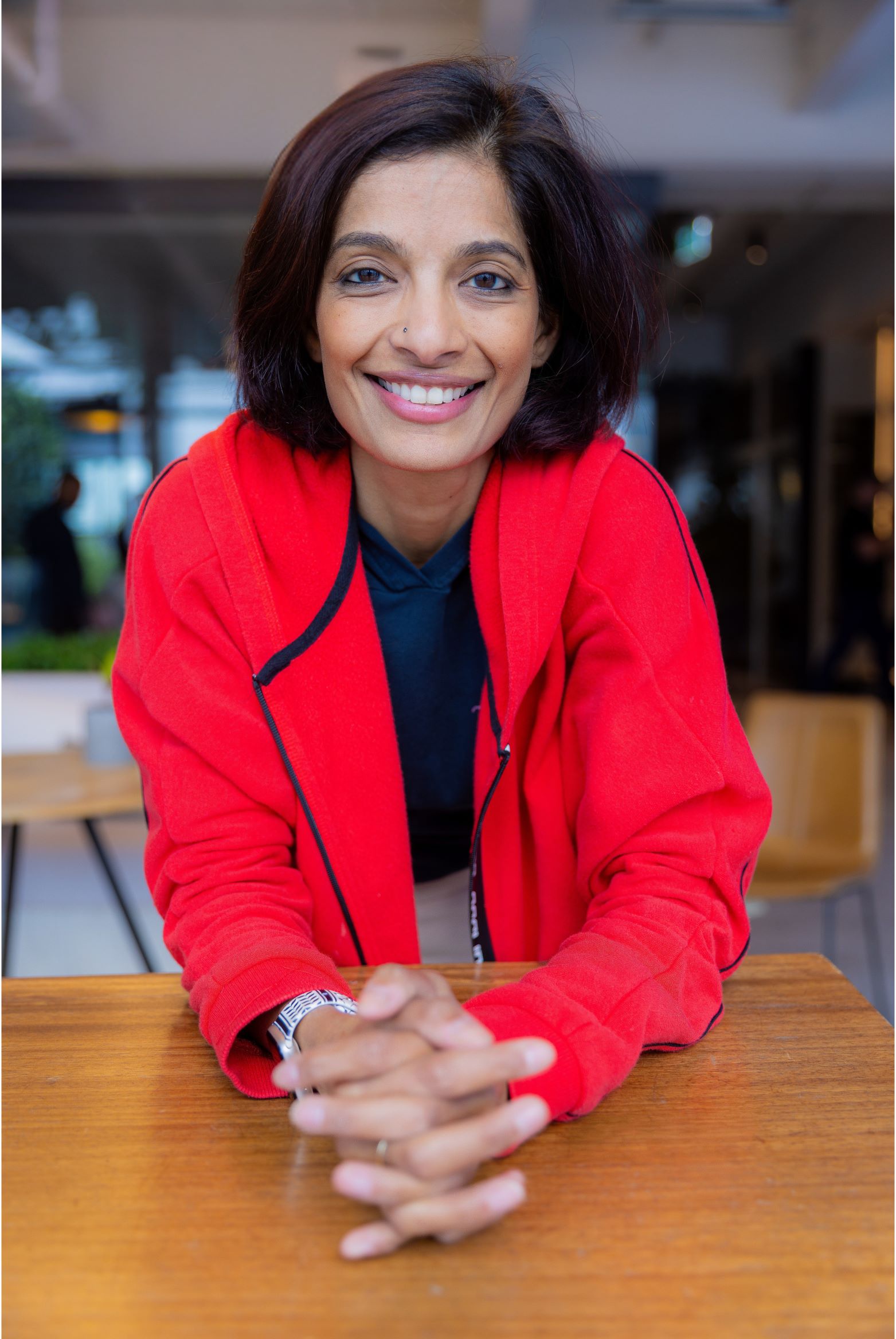
Arva Ahmed is the co-founder of Frying Pan Adventures, Dubai’s first food tour company, and a celebrated food explorer known for uncovering Dubai’s hidden culinary gems. Her expertise in the city’s diverse food scene has been featured in prominent publications such as CNN, Khaleej Times, BBC Travel, The Sun, The Independent and countless more. She also hosts Ditch the Silver on YouTube. Through her immersive tours and storytelling, Arva brings Dubai’s rich flavors and vibrant cultures to life.

